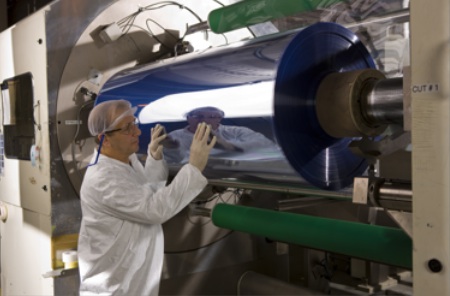Konarka Technologies, Inc., a company we have been following on The Sietch for a long time, today announced the company has opened the largest roll-to-roll flexible thin film solar manufacturing facility in the world, preparing for the commercialization and mass production of its patent-protected thin film solar material, Power Plastic. Located in New Bedford, Massachusetts, the 250,000 square foot building was previously the location for Polaroid Corporation’s most advanced printing technologies.
“This facility has state-of-the-art printing capabilities that are ready for full operation, with the future potential to produce over a gigawatt of flexible plastic solar modules per year,†commented Howard Berke, executive chairman and co-founder of Konarka. “Our technical leadership and innovation in flexible thin film solar, along with this facility’s capabilities of producing in excess of 10 million square meters of material per year, will allow us to produce Power Plastic for indoor, portable, outdoor and building integrated applications.â€
With this U.S. based manufacturing location, Konarka further expands its presence in Massachusetts and accelerates its aggressive plans to develop and commercialize its polymer-based organic photovoltaic (OPV) technologies worldwide. In addition to acquiring the fully automated roll-to-roll manufacturing line, the company has also hired the leading technology and process engineering teams from Polaroid, with plans to hire over 100 additional employees as production increases toward capacity over the next two to three years.
Konarka’s advanced photovoltaic technology started with the work of the late Dr. Sukant Tripathy, an internationally known polymer materials scientist, provost at UMASS Lowell and founder of the Plastic Innovation Center and Dr. Alan Heeger, Konarka’s chief scientist, who was awarded the Nobel Prize in chemistry in 2000. The ground-breaking discoveries from both founding scientists led to Konarka’s underlying technology leadership, including a manufacturing process at relatively low temperatures, which enables the use of low-cost plastic substrate films. As a result of these pioneering innovations, the company has secured over $100 million from leading venture capital and private equity funds, as well as $18 million in government agency research grants from the U.S. and Europe.
“Since 2001, Konarka has taken revolutionary lab discoveries from its founding scientists to pilot production for initial customers and now to full-scale manufacturing with the near future capacity of one gigawatt per year, which could contribute to the power and electricity needs of our nation and the avoidance of CO2 emissions,†commented Rick Hess, president and CEO at Konarka. “As one of the original recipients of the Solar American Initiative (SAI) awards in 2007, Konarka is furthering the U.S. Department of Energy’s (DOE) vision to reach its goal of making solar electricity from photovoltaics cost-competitive with conventional forms of electricity.â€
In addition to global and national interest, the project has been assisted by various Massachusetts departments and quasi-public agencies, including the Massachusetts Governor’s Office, the Executive Office of Housing and Economic Development, the Executive Office of Energy and Environmental Affairs, MassDevelopment and the Massachusetts Technology Collaborative’s Renewable Energy Trust Fund and Green Energy Fund.
“With our nationally recognized technology expertise and resources, Massachusetts is becoming a global center for alternative and renewable energy, and Konarka is helping to solidify our commitment to a clean energy future and ongoing economic development and job growth in the Commonwealth,†commented, Daniel O’Connell, Massachusetts Secretary of Housing and Economic Development.
The company has also partnered with the City of New Bedford to become a Certified Project under the Massachusetts Economic Development Incentive Program (EDIP). Under the EDIP, Certified Projects receive favorable state and local tax treatment in exchange for committing to certain job creation and private investment criteria. The EDIP is designed to increase economic activity within the Commonwealth’s identified Economic Target Areas (ETAs) and the City of New Bedford has historically utilized the EDIP as one of its key economic development planning tools.
Scott W. Lang, Mayor of New Bedford, added, “We are excited that Konarka is bringing new jobs to help further drive the economy and interest in the city of New Bedford, and we are proud that our city is home once again to an industry leading manufacturing plant.â€
Constructed and further expanded in the 1990’s for Polaroid’s advanced technology development and large-scale manufacturing, Konarka’s New Bedford facility has been retrofitted to immediately begin initial production of Power Plastic. Using multiple in-line processing stations with precision multi-layer manufacturing processes that are adaptable to a variety of printing and coating technologies, the facility will enable the company to further develop and advance nano-enabled polymer photovoltaic materials that are lightweight, flexible and more versatile than traditional solar materials.
So even in these dire economic times it seems that renewable energy is still a strong bet, I was very happy to hear that it was mentioned many times last night in the presidential debate. Clearly if we want to continue to have an economy, it must be a smaller, more sustainable, and renewable energy based one.


3 thoughts on “Konarka Opens One Gigawat Roll To Roll Plant”
Comments are closed.